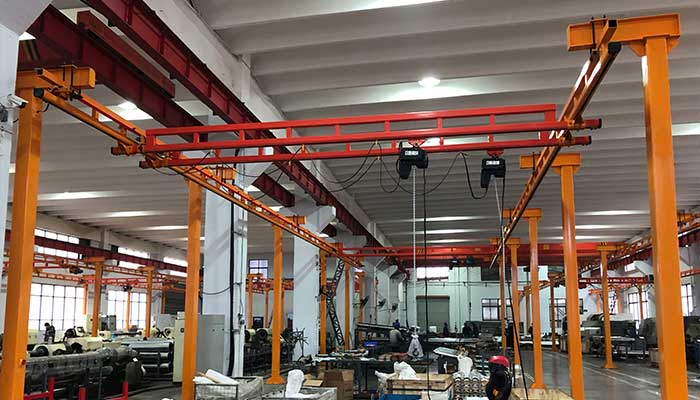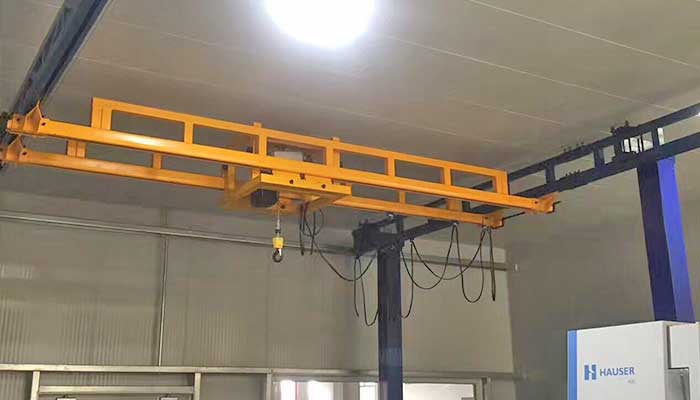Cost-Benefit Analysis of KBK Workstation Cranes, Get Your Design
KBK workstation cranes are versatile and flexible lifting solutions designed to enhance operational efficiency in various industrial settings. These cranes are modular, allowing for easy customization and adaptation to different workspace requirements. By using a system of rails, they enable smooth and precise movement of loads, which significantly reduces the manual effort needed in material handling. This adaptability makes KBK cranes suitable for diverse applications, from assembly lines to warehouses.
Conducting a cost-benefit analysis when considering the investment in KBK systems is crucial for businesses. This analysis helps organizations understand the financial implications of the purchase, including initial costs and long-term savings. It provides insight into how KBK cranes can improve productivity, reduce labor costs, and enhance overall efficiency. By assessing both the direct and indirect benefits of these systems, companies can make informed decisions that align with their operational goals and financial objectives.
single girder kbk workstation cranes
KBK Workstation Cranes
Definition and Features
KBK workstation cranes are a type of modular overhead crane system, characterized by their lightweight structure and ease of installation. These cranes typically consist of aluminum or steel profiles that form a rail system, allowing for various configurations. Key features include:
- Modularity: The ability to customize the crane layout to fit specific workspace dimensions and requirements.
- Lightweight Design: The use of materials that reduce the overall weight, making installation easier and requiring less structural support.
- Smooth Operation: Equipped with low-friction components that facilitate effortless movement of loads, minimizing manual effort.
Types of KBK Systems and Their Applications
There are several types of KBK systems, each designed for specific applications:
- KBK Aluline Cranes: These cranes are made from lightweight aluminum, making them ideal for environments where weight restrictions are a concern. They are commonly used in assembly and packaging areas.
- KBK Steel Cranes: Heavier than their aluminum counterparts, these cranes are built for more demanding applications. They can handle larger loads and are often found in manufacturing facilities and warehouses.
- KBK Flex and KBK Mono Cranes: These systems are designed for flexible movement, allowing operators to reposition loads easily. They are well-suited for assembly lines where products need to be moved frequently.
- KBK BGV Crane Systems: These cranes are designed with a focus on safety and are commonly used in environments where hazardous materials are handled, such as chemical plants and labs.
Each type of KBK system offers unique benefits, allowing businesses to select the right solution for their operational needs. The modularity and adaptability of these cranes ensure that they can be tailored to various industrial applications, enhancing efficiency and productivity across different sectors.
Evaluating the ROI of Investing in KBK Systems
Initial Costs
When considering the investment in KBK systems, it’s essential to evaluate the initial costs involved.
- Purchase and Installation Expenses: The price of the KBK crane system can vary based on its design, capacity, and configuration. Installation costs also play a significant role, as proper setup is crucial for safety and functionality. Investing in professional installation may incur additional expenses but can ensure that the system operates optimally.
- Training and Maintenance Costs: To maximize the benefits of KBK cranes, personnel must be trained on their operation and safety procedures. This training can add to initial costs but is essential for minimizing accidents and enhancing efficiency. Ongoing maintenance is also necessary to keep the system running smoothly, which may involve routine inspections, repairs, and replacement of parts over time.
Potential Revenue Increases
Investing in KBK systems can lead to significant revenue increases through enhanced operational efficiency.
- Enhanced Productivity Metrics: By streamlining material handling processes, KBK cranes can significantly boost productivity. With faster load movements and reduced downtime, companies can accomplish more in less time, directly impacting output levels.
- Improved Operational Capabilities: The flexibility of KBK cranes allows businesses to adapt to varying workloads and tasks. This adaptability enables organizations to take on more projects or handle larger quantities of materials, contributing to increased revenue potential.
Timeframe for ROI
Understanding the timeframe for ROI is crucial for evaluating the financial viability of investing in KBK systems.
- Short-Term vs. Long-Term Perspectives: In the short term, companies may see immediate benefits in productivity and efficiency, leading to quicker returns on investment. However, long-term benefits often encompass greater cost savings through reduced labor and maintenance expenses, as well as increased capacity for handling work. Assessing both perspectives allows businesses to plan effectively and understand the full impact of their investment over time.

Long-Term Savings Through Reduced Labor
Labor Efficiency
Investing in KBK workstation cranes significantly enhances labor efficiency in various ways:
- Reduction in Manual Handling: KBK systems streamline the movement of materials, minimizing the need for manual lifting and carrying. This reduction in physical effort not only speeds up processes but also allows workers to focus on more complex tasks that require their skills, ultimately improving overall productivity.
- Decreased Labor Costs Over Time: As efficiency increases, the need for additional labor often decreases. Organizations can achieve the same or greater output with fewer employees, leading to substantial savings on labor costs. Additionally, the improved efficiency can result in higher output levels, further maximizing the return on investment.
Employee Safety and Satisfaction
The implementation of KBK cranes also has a positive impact on employee safety and morale:
- Impact on Workforce Morale: When workers operate in a safer and more efficient environment, their job satisfaction tends to improve. Reduced physical strain and the knowledge that safety is prioritized foster a more positive workplace culture. Satisfied employees are typically more engaged, which can lead to increased productivity and lower turnover rates.
- Reduction in Workplace Injuries: By minimizing manual handling, KBK cranes significantly lower the risk of workplace injuries, such as strains and sprains. A safer work environment not only protects employees but also reduces costs associated with medical claims, training replacements, and lost productivity due to injuries. As a result, companies can enjoy both financial savings and a more stable workforce.

ceiling mounted kbk workstation crane for sale
Enhanced Efficiency
Streamlined Operations
KBK workstation cranes significantly enhance operational efficiency by improving workflow and process integration:
- Improved Workflow and Process Integration: KBK systems are designed to facilitate seamless movement of materials, allowing for better coordination between different stages of production. This integration helps eliminate bottlenecks, reduces idle time, and ensures that materials are delivered to the right location at the right time, ultimately enhancing overall productivity.
Flexibility and Adaptability
One of the standout features of KBK cranes is their flexibility and adaptability:
- Customization Options for Different Tasks: KBK systems can be tailored to meet specific operational needs, making them suitable for a variety of applications. Whether in assembly lines, warehouses, or specialized manufacturing, these cranes can be configured to handle different loads and tasks, allowing businesses to adapt quickly to changing demands without significant additional investment.
Increased Equipment Lifespan
Investing in KBK cranes contributes to the longevity of equipment:
- Reduced Wear and Tear on Machinery: The design of KBK systems minimizes strain on both the crane itself and other equipment in the facility. By facilitating smoother and more efficient material handling, these cranes help reduce the likelihood of mechanical failure or damage, leading to lower maintenance costs and an extended lifespan for all machinery involved. This durability not only preserves capital investment but also enhances overall operational reliability.
Case Studies and Real-World Applications
Success Stories
Numerous businesses have successfully implemented KBK workstation cranes, reaping substantial benefits:
- Automotive Manufacturing: A leading automotive manufacturer integrated KBK cranes into its assembly line, resulting in a 30% increase in production efficiency. By streamlining material handling, workers could focus more on assembly tasks, reducing bottlenecks and speeding up the overall process.
- Electronics Assembly: An electronics firm adopted KBK systems to manage its intricate assembly process. The flexibility of the cranes allowed for quick reconfiguration as product lines changed, leading to a significant reduction in setup times and a marked improvement in operational agility.
- Logistics and Warehousing: A logistics company implemented KBK cranes in its warehouse to facilitate the movement of heavy packages. This not only enhanced safety by reducing manual lifting but also improved order fulfillment speed, resulting in higher customer satisfaction rates.
Lessons Learned
While many businesses have enjoyed the benefits of KBK systems, they also encountered challenges:
- Common Challenges: Some companies faced initial resistance from employees who were accustomed to traditional handling methods. Additionally, training staff to effectively operate the new systems took time and effort.
- Solutions: To address these challenges, businesses invested in comprehensive training programs that emphasized the safety and efficiency advantages of KBK cranes. Encouraging employee feedback during the transition helped identify areas for improvement and fostered a sense of ownership among workers. By involving staff in the implementation process, companies were able to ease the transition and maximize the benefits of their new systems.
These case studies highlight the tangible advantages of KBK workstation cranes while underscoring the importance of addressing challenges through proper training and employee engagement.
Conclusion
In summary, investing in KBK workstation cranes offers a range of benefits that can significantly enhance operational efficiency and reduce costs. The modular design and flexibility of these systems lead to streamlined operations, improved labor efficiency, and increased employee safety and satisfaction. Over time, businesses can expect substantial savings through decreased labor costs, reduced wear and tear on equipment, and enhanced productivity metrics.
As companies consider the investment in KBK systems, it is crucial to weigh both the initial costs and the long-term benefits. A thorough cost-benefit analysis will help organizations understand the potential return on investment, ensuring that the decision aligns with their operational goals. By prioritizing employee training and engagement during implementation, businesses can maximize the advantages of these systems and create a safer, more efficient workplace.
In conclusion, KBK workstation cranes represent a smart investment for organizations looking to improve their material handling processes and achieve significant long-term savings.




